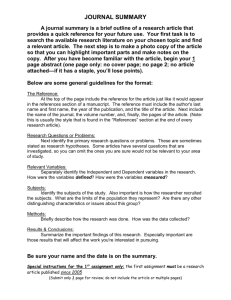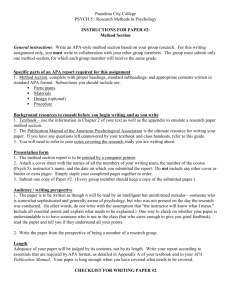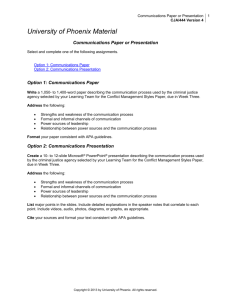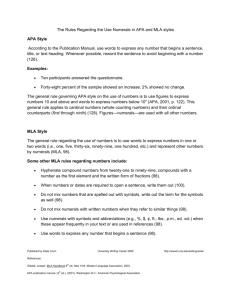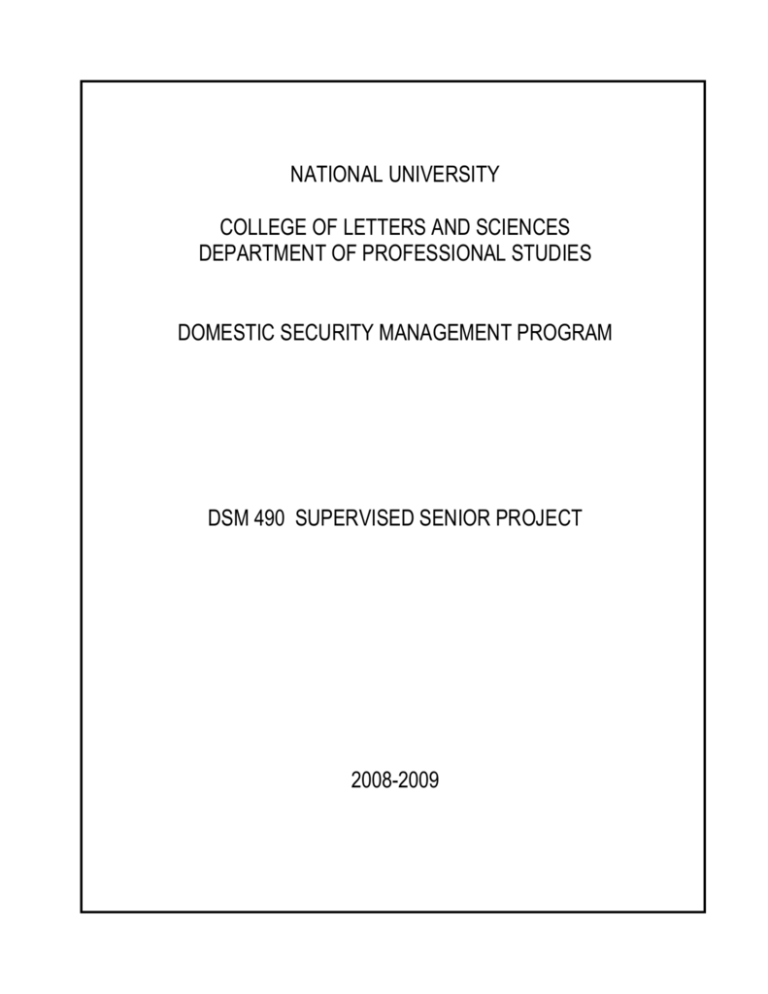
NATIONAL UNIVERSITY
COLLEGE OF LETTERS AND SCIENCES
DEPARTMENT OF PROFESSIONAL STUDIES
DOMESTIC SECURITY MANAGEMENT PROGRAM
DSM 490 SUPERVISED SENIOR PROJECT
2008-2009
Description of the Senior Research Project
The supervised senior project is undertaken by students of domestic security management program once they
have completed all core courses in the program. The project is coordinated by full-time faculty and chaired by a DSM
faculty member, or other qualified individual, chosen by the student from previous courses taken within the program. Each
student will select a committee and a viable topic in criminal justice to research. Students meet as a class once a week for
two months. Upon completion of the project, students present the project to the committee, other faculty, and peers in an
open forum.
Goals of the Senior Research Project
The purposes of this course are to provide students with the opportunity to acquire and demonstrate the skills
involved in developing and designing a viable research project; collecting and analyzing data; evaluating research data and
drawing conclusions; make an oral presentation of research findings; and applying the APA format.
Objectives of the Senior Research Project
Upon completion of the thesis, students will be able to:
1.
2.
3.
4.
5.
6.
7.
8.
9.
10.
develop a research question;
formulate a testable research hypothesis;
conduct a literature review;
describe an appropriate methodology to answer the research question;
collect and analyze data;
draw conclusions and make recommendations based on the available data;
make an oral presentation of research findings;
demonstrate an understanding of the ethical issues surrounding the collection and reporting of research data;
understand the role research plays in the development of criminal justice and criminology; and
describe how diversity issues may influence choice of research topics, research methodology, and the
application of research findings to the justice system.
Requirements of the Senior Research Project
Each student must complete a research project that conforms to the requirements described in the handout DSM
490 Senior Project - Requirements. Each project must be organized into a five-chapter format on a topic related to the field
of criminal justice. Research projects will utilize a methodology appropriate for the research topic.
Each student must present the findings of his or her research project to the student’s committee, other faculty, and
peers in an open forum. The presentation is approximately 20 minutes in duration.
2
Section 1: Organization of Contents
Elements
The following preliminary pages (numbered in lowercase Roman numerals) precede the body of the thesis, in this
order:
title page
thesis approval page
copyright page (if you plan to register a copyright)
dedication page (optional)
acknowledgments (optional)
abstract
table of contents
list of tables (if appropriate)
list of illustrations (charts, graphs, figures) (if appropriate)
list of symbols (if appropriate)
preface (optional)
Paginated in Arabic numerals is the text and other pages following the preliminary pages arranged in the following
order:
text (chapters of the manuscript)
endnotes
appendices
references
index (optional)
Title Page
All Senior Projects must carry the following information on the title page:
A research project presented to the faculty of National University in partial fulfillment of the requirements
for the degree of Bachelor of Science in Criminal Justice.
Refer to sample page in back.
Project Approval Page
Obtain original signatures of the committee chair and readers. Type only as many lines as there are committee
members signing. Signatures must be in permanent black ink. Refer to sample page in back.
3
Copyright Page
This page is necessary only if the project is to be registered with the Federal Copyright Office. Refer to sample
page in back.
Dedication
Use discretion in making a dedication. The dedication should be consistent with the topic of the research.
Acknowledgments
Use discretion in making acknowledgments. It is customary to acknowledge special assistance from extramural
agencies. There is no obligation that assistance received from members of the committee be acknowledged.
Acknowledgments should be couched in terms consistent with the scholarly nature of the work. Your name and date should
not appear on this page.
Abstract
All abstracts must be double-spaced and the title should simply be ABSTRACT. The abstract can be no more
than 350 words.
Table of Contents
The table of contents is designed for the convenience of the reader. It should include the acknowledgment page,
abstract, list of tables, list of illustrations, list of abbreviations or symbols, appendices and references as well as the major
sections in the text. Do not list the “Title Page” or “Table of Contents” in the table of contents. Please note the following:
you must have dot leaders between the end of a heading and its page number
headings in the table of contents should appear as they do in the text
List of Tables
The term “table” applies to numerical and statistical data set in vertical or horizontal alignment. If there are tables
in your text/appendix, a list of tables must be included. The “List of Tables” is on a page by itself and arranged in the same
general format as the Table of Contents. Type the table numbers in Arabic numerals, and the titles in capital and small
letters, with period leaders extending from the last letter of the title to the page number. Please note:
Titles may be shorter than they appear in the text as long as they are not misleading. Titles may not be
longer than the titles in the text.
Numbering of tables. You have two options: (a) You may begin by numbering the first table with the numeral
“1” and continue to number your tables consecutively throughout the entire manuscript; or (b) you may
number the first table in each chapter with the numeral “1” and continue to number your tables consecutively
within each chapter. For example, if chapter four has three tables and chapter five has three tables, the
numbering would be as follows: 4.1, 4.2, 4.3; 5.1, 5.2, 5.3.
Single space within titles which are longer than one line, but double space between each entry.
List of Illustrations (charts, graphs, figures)
This list is also placed on a page by itself and arranged in the same general format as the Table of Contents.
Designate figure numbers with Arabic numerals, and plate numbers, if any, with capital Roman numerals. If the thesis
contains both figures and plates, arrange them on separate lists.
4
List of Symbols
If symbols are needed in the text, a list should be provided to explain their definitions or meanings. The list should
be placed on a separate page and included where specified by these instructions.
Preface
A preface, while optional, enables you to explain your purpose and perhaps justify your choice of a topic. The
preface is also an appropriate place to present an overview of the project, including a description of what is to be found in
each chapter. If utilized, it is part of the preliminary pages (numbered with Roman numerals) and therefore precedes the
main text.
Text
The organization of the text varies somewhat with the subject matter. The project is divided into five chapters,
each chapter titled and beginning on a new page. In general, the content of the five chapters include:
Chapter I: Introduction
The first chapter provides an overview of the project. The specific subsections of this chapter will vary, depending
on the subject matter. In general, the first chapter should include the following information:
Background of the Study: provide a brief history of the ideas and issues related to the research topic. This
section should not be a review of the literature (though some information may be repeated in the literature review), but a
description of the events leading up to this research.
Problem Statement: this is the heart of the research project. This subsection states the reason(s) why this
research project is important. A good way to approach the Problem Statement is to address the following: Because of x
and y, there is a problem in society (or the criminal justice system or the field of forensic science); if only we knew more
about z, things might be better. The research project should be designed to answer z, which is the research question.
Purpose and Objectives of the Study: list the component parts of the research question. Rarely is a problem in
criminal justice one dimensional. This subsection should describe the specific elements of the problem being addressed by
the research.
Rationale of the Study: develop the reasons for examining the elements described in the purpose and
objectives section. Explain why those elements were selected, how they relate to the topic of the research, and how they
related to each other. In other words, explain how will accomplishing the purpose and objectives answer the research
question.
Definition of Terms: list definitions for only those terms which might be unfamiliar to the reader, especially those
which can be considered terms of art and operational definitions.
Limitations of the Study: describe self imposed limits on the research, including those that relate to both the
breadth and depth of the inquiry. Also include limitations that exist due to factors beyond your control. Describe the
(potential) effects the particular limitations may have on your research.
Theoretical Framework: if the research is driven by, or relates to, a particular theoretical orientation, provide a
brief overview of that orientation and how it relates to the research.
Research Hypotheses: based on the purpose and objectives, what are the expected outcomes for the research?
Hypotheses are essentially predictions about the answers to the research question and its component parts. The research
hypotheses are a critical element of the research project: they will guide the literature review; heavily influence the research
methodology needed to obtain data that will either support or reject the hypotheses; and provide the focus for data analysis,
discussion, conclusions, and recommendations.
Summary of Remaining Chapters: include a brief summary of the first chapter and describe the content of the
remaining chapters. If a preface is utilized, this subsection is not necessary.
Chapter II: Literature Review
The second chapter should not be confused with the Introduction in Chapter I. The introduction provides a review
of the topic; the Literature Review summarizes what has been said about the topic. The Literature Review is not a series of
book (or journal article) reports. A good literature review tells a story about the topic, using published works to support what
5
is written. The chapter should be organized in such a way as to (a) bring together the most important writings about the
research question in general, followed by (b) a closer examination of the writings related to the component parts detailed in
the Purpose and Objectives subsection of Chapter I. It is very helpful to the reader if the ideas are presented in the same
order throughout the thesis.
This chapter will contain the greatest number of citations, so it is important that they be done correctly. Each
citation must have a corresponding listing in the Reference section.
The Literature Review should not include data that will be used to answer the research question or test your
research hypotheses. If the project is utilizing an analysis of published research to answer the research question, the
Literature Review should provide the background and take the reader up to the point where those studies begin.
Chapter III: Methodology
In general, this chapter describes how the data were collected that answer the research question and its
component parts. It is important to utilize appropriate methods of data collection in order to be able to support or reject the
research hypotheses. This chapter should begin with a description of the research methods used in the research, including
a description of the dependent and independent variables, if any. Chapter III will most likely include the following
subsections:
Setting: if important to the research, describe the time and place of data collection.
Description of the Subjects: depending on the type of data used in the project, this subsection can include
either subjects involved in primary data collection, or those described in published research studies. If the project involves
human subjects, it is necessary to first obtain their consent in writing.
Description of the Research Instrument(s): fully describe all questionnaires and tests, if appropriate. Include a
copy of questionnaires in the Appendix.
Procedures: describe in full detail how data were collected. If different methods were used, each method must
be described. This subsection should also include a description and rationale for any statistical procedures used to support
or reject the research hypotheses.
Chapter IV: Results
This chapter includes a presentation and analysis of the data. The tone of the chapter is purely objective, devoid
of assumptions and interpretations.
Following a summary of the research data, Chapter IV should be organized in a manner consistent with the
research hypotheses: first, present data related to the first hypotheses; and second, analyze those data to determine
whether the first hypothesis can be supported or rejected. Follow this sequence for each hypothesis.
Tables are an effective way to present quantitative data. Qualitative data should be summarized, as opposed to
verbatim transcriptions.
Chapter V: Discussion, Conclusions, and Recommendations
This chapter involves (a) a discussion of the research project, including the findings, interpretation of the results,
and problems and/or limitations; (b) a conclusion: what did we find out? what did we learn? and (c) recommendations for
changes in policy or practice, future research, or anything else that will direct solutions to the problem(s) that were the focus
of the research.
Endnotes
Endnotes supplement or amplify information in the text. They should be used sparingly: if the information is of
central importance, it should be included in the text; if the information is irrelevant or nonessential, it should be excluded;
however, if the information is tangential, and more fully develops an element of the text, endnotes may be appropriate.
Endnotes can be included at the end of each chapter or at the end of all the text.
6
Appendix or Appendixes
The main purpose of the appendix (or appendixes) is (are) to provide detailed information that would be
distracting if presented in the text. For example, a survey instrument or questionnaire, a data collection form, or a list of
variables would be appropriate for placement in an appendix.
References
Only those works cited in the text appear in the Reference section and, conversely, every work in the Reference
section must appear in the text. It is important to properly cite all references.
Index
An index can be extremely useful, but also difficult to create. Consider including an index only if word processing
software facilitates its creation.
Section 2: Format For Text
Style
The Criminal Justice and Forensic Sciences Programs have adopted the style of the American Psychological
Association (APA). While there are a number of style manuals available, all Masters Theses must conform to APA style as
described in the Publication Manual of the American Psychological Association (4th Edition). It is the responsibility for each
student to make sure their project conforms to the proper style. Do not use running headers.
Margins
Standardized margins are required on every page to ensure that no part of the project is cut off when it is bound
and trimmed. The left margin must be 1½ inches from the edge; all other margins must be at least 1 inch from the edge.
Line Spacing
Double spacing is required except where the style calls for single spacing (refer to APA Manual). Widows (the last
line of a paragraph as the first line of a page) or orphans (a heading or the first line of a paragraph as the last line on a
page) are not acceptable.
Punctuation
Many common manuscript problems involve punctuation. Most problems can be alleviated by selecting
committee members who are good writers and who are familiar with APA style.
Pagination
Every page must be counted in the numbering. With the exception of the title page, a number must appear on
every page. Placement of page numbers must be consistent throughout and fit within the margins. Page numbers for
preliminary pages using Roman numerals appear centered at the bottom of the page; pages using Arabic numerals appear
in the upper right edge of the paper, one inch from the right edge and one inch from the top.
Chapters
Each chapter must begin on a new page. Chapters should be numbered. Refer to the APA Style Manual for
different styles of headings.
7
Section 3: Illustrations
The purpose of illustrations (drawings, photographs, diagrams, maps, tables, plates, etc.) is to present information
more clearly than can be done with words. Legends or titles should be self-explanatory, concise, and consistent in form.
Refer to the APA Style Manual.
Tables
The term “table” applies to numerical and statistical data set in vertical and horizontal alignment. Tables over half
a page in length should be placed on a separate page. Tables too wide to be accommodated on one page may be typed on
two or more pages, pasted together, and either folded or reduced to page size by a suitable photographic process. Lengthy
tables should be placed in the Appendix.
Footnotes for tables are to be indicated by standard symbols (*, etc.) or lower-case letters (a, b, etc.). Do not use
numbers for footnotes to tables. Footnotes are placed at the bottom of the table, not the bottom of the page.
Figures
The term “figure” refers to illustrations such as graphs, charts, diagrams, photographs, and maps, but not
statistical data presented in tables. Refer to the APA Style Manual for the various styles.
Section 4: The Final Copy
Typing and Printing of the Manuscript
The Senior Research Project is expected to be the product of neat and careful work by all concerned. The
physical appearance must be immaculate and convey an impression of pride and quality in behalf of the student, the
advisory committee, the program, and the university.
Your manuscript must be prepared on either a typewriter, word processor, personal computer, or mainframe
computer. However, all print in the project must meet the following standards:
Any standard typeface is acceptable (although a font such as Courier is recommended) as long as the same
typeface is used throughout the manuscript, with the exception of certain appendix material or legend on charts, which may
be put in a different type. Italics should be used only to highlight specific words or phrases in the text, and only rarely.
The type size should be 12-point for all material in the text (this includes any reduced material which may be
included in the Appendix).
The print should be letter quality (typewriter or letter-quality printer, 300 dots per inch, 24-pin printer) with dark
black characters that are consistently clear and dense. Dot matrix is unacceptable. If you are uncertain about the quality of
print generated by your computer, bring a sample to your instructor.
Print on one side of the page only.
Paper
Use only white paper, 8½ by 11 inches, unpunched, of 20-pound weight. Do not use erasable paper.
Substandard paper may be used for rough drafts.
Reproduction
Reproduced copies are acceptable if high quality photocopying is used. Photocopied signatures are acceptable
for all copies except the original.
Number of Copied to Submit
A minimum of one copy of the research project, bound with a clear plastic cover, is required. That copy of the
bound project is turned in to the course instructor who will keep the project on file. In addition, the student may elect to
submit a copy, also bound with a clear plastic cover, to the University library. It is also customary to give one bound copy
each to the project chair and readers.
8
Sample of Title Page for Senior Research Project
YOUR TITLE
A RESEARCH PROJECT SUBMITTED TO THE FACULTY OF NATIONAL UNIVERSITY
IN PARTIAL FULFILLMENT OF THE REQUIREMENTS FOR THE DEGREE OF
BACHELOR OF SCIENCE IN DOMESTIC SECURITY MANAGEMENT
SEPTEMBER 2006
By
Jane E. Doe
Senior Research Project Committee:
Nell Ford, Chairperson
Adrian Lennox
Leslie Barton
9
Sample of Project Approval Page
SENIOR RESEARCH PROJECT APPROVAL FORM
We certify that we have read the project of Jane E. Doe entitled Instructions for the Preparation of the Senior Research
Project and that, in our opinion, it is satisfactory in scope and quality for the degree of Bachelor of Science in Criminal
Justice at National University.
Approved by:
Nell Ford, Chairperson
Date
Adrian Lennox
Date
Leslie Barton
Date
10
Sample of Copyright Page
Copyright © 2006 by Jane E. Doe
All Rights Reserved
11


